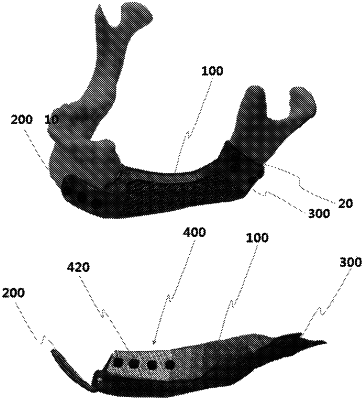| CPC A61F 2/2803 (2013.01) [A61B 6/14 (2013.01); A61F 2/30942 (2013.01); B33Y 50/00 (2014.12); B33Y 80/00 (2014.12); A61B 6/032 (2013.01); A61F 2002/30948 (2013.01); A61F 2002/30952 (2013.01); A61F 2002/30985 (2013.01); A61F 2310/00023 (2013.01)] | 1 Claim |

|
1. A patient-specific implant configured to be inserted into a mandibular defect region of a patient, comprising:
a body (100) having an outer contour corresponding to the mandibular defect region and made of a porous metal material;
a first fixture (200) configured to be fixed to a first defect end formed at one end of the mandibular defect region;
a second fixture (300) configured to be fixed to a second defect end formed at another end of the mandibular defect region; and
a dental-root restoration section (400) corrected to restore a defective part corresponding to a tooth root in the body, wherein:
the dental-root restoration section (400) is formed of a dental-root support (410) or a dental-root hole (420) only with respect to a mandible of a tooth junction region of the patient;
the body (100) is made of titanium, and when the body is produced by a 3D printer, the body is produced by a method of melting and laminating a metal material using an additive manufacturing process in which a metal material is melted and then manufactured in a same manner as a generated image;
the dental-root restoration section (400) is designed in consideration of a pressure applied during chewing between a defective tooth and an upper tooth of the patient;
the dental-root restoration section (400) is 3D-printed based on a root of an opposite tooth that is not defective;
the dental-root restoration section (400) is inclined at a certain angle from a horizontal plane so that upper and lower teeth of the patient are parallel and matched to each other, thereby preventing damage to the upper and lower teeth during continuous chewing;
in the 3D printing, when there is no opposite mandibular scan information, when there is no opposite tooth root information, or when a mandible of a deficient patient is completely lost, a new information extraction section acquires information on nationality, gender, and height of the patient, and extracts a defect region using a size, volume, and density of the mandible from a standard mandible database (DB) for each nationality based on the acquired information; and
the standard mandible DB for each nationality is a database made in consideration of a size, volume and density of a mandible for each country, and stores an average mandibular size, volume, and density according to gender or height for each nationality;
wherein
the first fixture (200) and the second fixture (300) are formed as flaps or flanges each having holes formed at regular intervals, the first fixture (200) and the second fixture (300) projecting respectively from a first end of the body, the first end of the body corresponding to the first defect end, and a second end of the body, the second end of the body corresponding to the second defect end;
the first fixture (200) is configured to extend beyond the first end of the body; and
the second fixture (300) is deformable and attachable as a partial sleeve partly encircling the second defect end formed at the other end of the mandibular defect region.
|